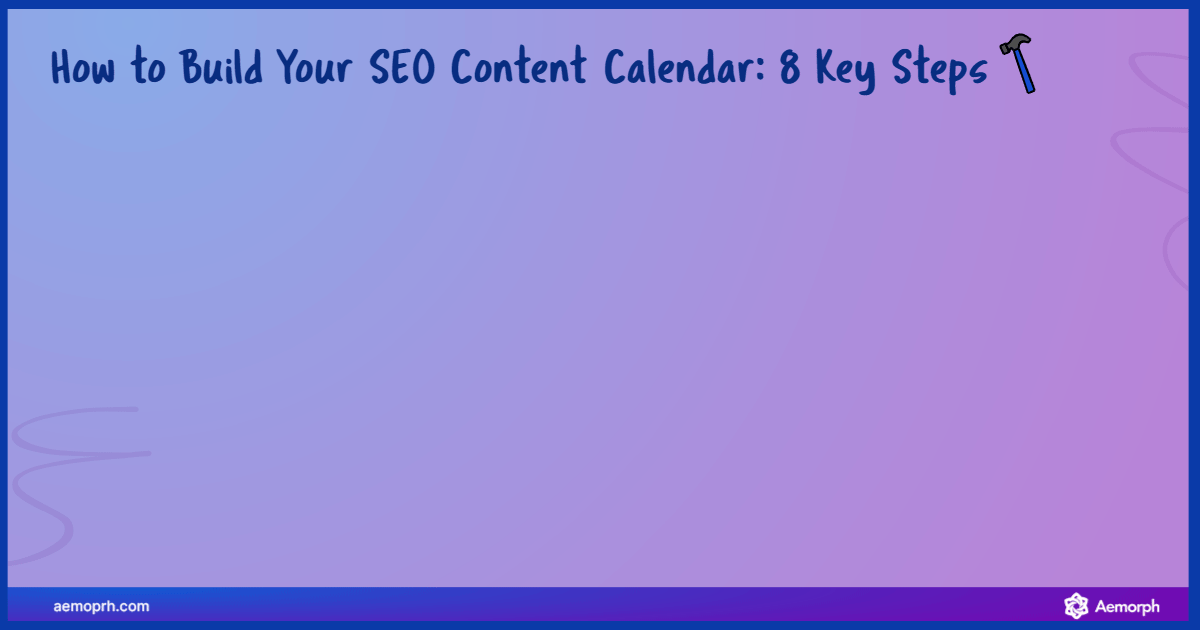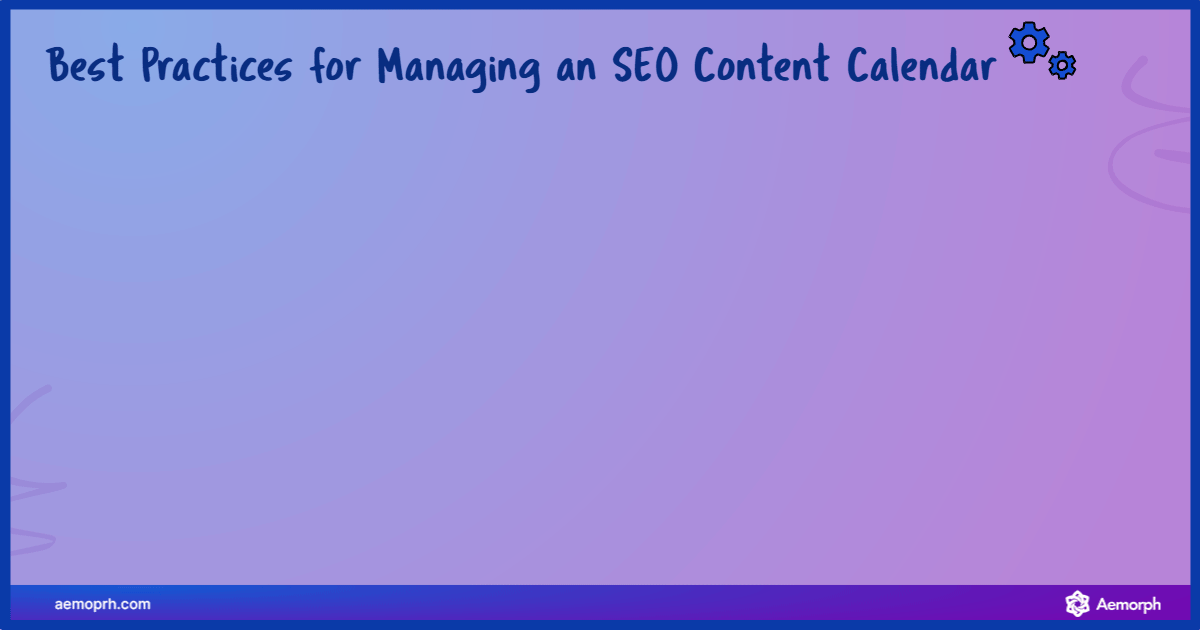
An SEO content calendar goes beyond a regular editorial calendar by ensuring every piece of content is optimised for search engines, aligned with target keywords, and designed to deliver measurable results. In this guide, we’ll explain the what, why, and how of creating a powerful SEO content calendar to boost your website’s performance and streamline content production.
What is an SEO Content Calendar?
An SEO content calendar is a structured timeline outlining when and what content will be published, focusing on optimising search engines. Unlike an ordinary content calendar, an SEO calendar maps out content designed to improve rankings on search engine results pages (SERPs).
The Role of a Content Calendar in SEO Strategy
A structured SEO content calendar helps you map your content in advance, ensuring it aligns with your SEO goals and user needs. This ensures consistency, enhances keyword targeting, and helps you stay organised throughout the year.
With search engines continuously updating their algorithms, especially Google’s focus on helpful content, a planned approach lets you pivot quickly while maintaining content flow. It also makes tracking performance and optimising content easier for better ranking, helping you stay competitive.
Why Your Business Needs an SEO Content Calendar

An SEO content calendar is a powerful tool for driving growth. Here’s why it’s essential for your marketing strategy:
Improved Search Rankings and Organic Traffic
Search engines favour fresh, relevant content. A well-planned SEO content calendar helps ensure you’re regularly producing optimised content that search engines can index and rank. By consistently targeting key keywords and topics that matter to your audience, your visibility on SERPs will improve, driving organic traffic over time.
Time Management and Efficiency
A content calendar provides a clear roadmap, allowing your team to plan and execute more efficiently. Instead of creating content last minute, you’ll focus on researching, writing, and optimising content in advance, which ensures quality while saving time.
Alignment with Business and SEO Goals
Your SEO content calendar should directly align with your business and SEO goals. Whether aiming to increase brand awareness or generate leads, the calendar helps keep your team on track, ensuring every piece of content serves a clear purpose.
Step-by-Step Guide to Building Your SEO Content Calendar
Here’s how to build a robust SEO content calendar to deliver results.

Step 1: Define Your SEO Goals
Before you start creating your content calendar, setting clear, measurable SEO goals is essential. These goals should be specific to what you want to achieve through organic search traffic. Common SEO goals might include:
- Increase organic traffic by a certain percentage over the year.
- Improve keyword rankings for target phrases critical to your industry.
- Boost conversions by driving traffic from high-intent keywords.
- Reduce bounce rates by publishing more relevant and engaging content.
These objectives must align with your business’s broader goals, like increasing revenue, generating leads, or building brand authority. By clearly defining these goals, you’ll have a focused direction to guide the types of content you create and how you prioritise them in your calendar.
Step 2: Conduct Keyword Research
Keyword research is the backbone of your SEO content calendar. Without the right keywords, your content won’t reach your target audience. Thorough keyword research allows you to understand what your potential customers are searching for, how they are phrasing their queries, and the level of competition you’re facing.
Tools like Google Keyword Planner, SEMrush, and Ahrefs are essential for identifying keywords that align with your business goals. These tools offer a wealth of data on search trends, keyword difficulty scores, and competitor analysis. For example, with Ahrefs, you can uncover which keywords your competitors are ranking for and identify content gaps where you can seize ranking opportunities.
Group Keywords by Topic and Intent
Once you’ve gathered a list of keywords, group them by topic and search intent. Organising keywords by topics (such as product reviews, how-tos, or guides) helps ensure you cover a variety of related content.
For example, if you run a fitness blog, you might group keywords around major topics such as workout plans, nutrition advice, and fitness gear reviews. Under each of these topics, you can categorise keywords by search intent:
- Informational keywords: These address queries where users are looking for knowledge or solutions, such as “how to start a home workout routine” or “best post-workout meals.” Content targeting these queries should aim to educate and provide detailed insights.
- Navigational keywords: These include branded searches or users seeking specific products or services, such as “Nike running shoes” or “Peloton bike reviews.” These keywords typically signal the user is moving toward a purchase decision.
- Transactional keywords: These indicate a user is ready to make a purchase or take an action. Keywords like “buy resistance bands online” or “best deals on home gym equipment” are highly transactional and should guide your content toward conversion, such as product reviews, comparisons, or landing pages with clear calls to action.
By grouping your keywords in this way, you’ll ensure that your content calendar has a balanced mix of content targeting users at every stage of the buying funnel—from initial research to the final purchase decision. This approach also ensures your content is relevant, improving user engagement and increasing the chances of higher search rankings.
Step 3: Identify Content Pillars for Your SEO Strategy
Content pillars form the backbone of your SEO strategy by organising your blog around key themes that reflect both your expertise and your audience’s interests. Each pillar should be broad enough to support multiple pieces of content but specific enough to target relevant keyword clusters.
In the context of a fitness blog, these pillars should be based on your keyword research and align with high-demand areas in fitness, health, and wellness.
Examples would be:
Workout Routines: This pillar encompasses all exercise routines, from strength training and cardio to flexibility and mobility exercises. Target keywords could include “workout routines for beginners,” “HIIT workouts,” or “best leg workouts.”
Fitness Gear and Equipment: This theme can focus on product reviews, buying guides, and tutorials for using various types of fitness equipment. Keywords might include “best home gym equipment,” “fitness gear for beginners,” or “how to use resistance bands.”
Step 4: Map Out Content Topics
Once you’ve established your content pillars, the next step is to translate those pillars into actionable content topics for your SEO content calendar. The goal here is to create content that fits within your pillars, aligns with your keyword clusters, and supports your SEO goals.
Using the fitness blog as an example, here’s how to translate the pillars into specific topics:
Workout Routines Pillar:
- “10 Best HIIT Workouts for Beginners”: Keywords might include “HIIT for beginners” and “HIIT workout routines.”
- “Full-Body Strength Training Routine You Can Do at Home”: Keywords could include “strength training at home” and “full-body workout.”
Each topic should serve a dual purpose: addressing the informational needs of your audience and driving traffic by targeting specific, relevant keywords. This ensures that every piece of content you produce builds authority around your content pillars and contributes directly to your SEO performance.
Step 6: Create a Consistent Publishing Schedule
A successful SEO content calendar relies on a regular publishing schedule. Consistency is key for both audience engagement and SEO performance, as search engines favour sites that regularly post fresh content.
- Determine the Right Frequency by assessing your resources. A consistent posting schedule — one blog per week or two blogs per month — is more effective than overcommitting and missing deadlines.
- Align Frequency with Audience Demand. Use tools like Google Analytics to see when your audience is most active.
- Use tools like Google Calendar or CoSchedule to map out publishing dates and ensure no overlap. Some options include:
- Trello: Great for visualising content pipelines.
- Google Sheets: Simple and effective for tracking deadlines.
- CoSchedule: Offers advanced features like analytics integration.
Consistent posting signals to search engines that your blog is active, improving your rankings. Stick to a manageable schedule that aligns with your goals to maintain audience interest and SEO growth.
Step 7: Implement Tools to Track SEO Performance
Tracking the performance of your content is essential for making data-driven decisions and improving your SEO strategy. Several tools can help you monitor how your content is performing:
- Google Analytics: This tool helps you track website traffic, user behaviour, and conversions. For example, you can monitor which fitness blog posts attract the most readers, where they’re coming from, and how long they stay on the page.
- Google Search Console: It allows you to monitor your site’s performance in Google search results. Track keyword rankings, identify indexing issues, and see which fitness-related queries drive your blog traffic. For instance, if “HIIT workouts” is a focus, you can track how well your content on this topic ranks.
By regularly using these tools, you can identify high-performing content and areas that need improvement, allowing you to fine-tune your SEO content calendar.
Step 8: Monitor and Adjust Your Calendar
Regular review of your SEO content calendar is crucial for keeping up with changes in SEO trends, user behaviour, and content performance. By analysing the data from tools like Google Analytics and Search Console, you can make informed adjustments to your strategy.
For example, if you notice that your posts on “HIIT Workouts” consistently drive the most traffic, consider adding more content around related topics like “HIIT Workouts for Beginners” or “HIIT vs. Strength Training.” Conversely, if a series of posts on “Yoga for Stress Relief” isn’t performing as expected, you might need to revisit the keywords or rewrite the content to better meet user intent.
This step ensures your content calendar remains dynamic and responsive to your audience’s needs and SEO developments, maximising its long-term effectiveness.
Best Practices for Managing an SEO Content Calendar

To ensure your SEO content calendar runs smoothly, follow these best practices:
Stay Flexible and Adaptable
SEO is constantly evolving, so reviewing your calendar is important. Make adjustments based on new keyword opportunities, changing audience interests, or SEO trends. For example, if a new fitness trend, like wearable tech for workouts, emerges, you can incorporate that into your content calendar to stay relevant and competitive.
Repurpose High-Performing Content
Maximise the value of successful posts by repurposing them into different formats, such as videos, infographics, or social media snippets. This helps you reach a broader audience without creating entirely new content from scratch, giving older posts renewed life and further enhancing SEO efforts.
Collaborate with Your Team for Efficiency
Maintaining a well-structured SEO content calendar requires efficient collaboration between team members, such as content writers, SEO specialists, editors, and social media managers. Effective collaboration helps streamline the process, ensuring that your content calendar stays on track and your SEO strategy is implemented seamlessly across all content.
Project management tools like Trello or Asana allow you to assign tasks, set deadlines, and monitor the progress of each content piece. Google Docs or Notion can provide a shared workspace where team members can collaborate on content drafts, leave comments, and edit in real time, ensuring all input is captured efficiently.
Conclusion: The Long-Term Benefits of an SEO Content Calendar
A well-structured SEO content calendar is essential for driving consistent traffic, improving search rankings, and staying relevant in a competitive digital space. By setting clear goals, organising your content around strategic pillars, and maintaining a regular publishing schedule, you ensure that your efforts are both efficient and impactful.
Leveraging SEO tools, repurposing high-performing content, and staying flexible in response to evolving trends will help you maximise the value of your content over time. Regularly reviewing and adjusting your calendar based on data-driven insights ensures your strategy remains dynamic and effective.









